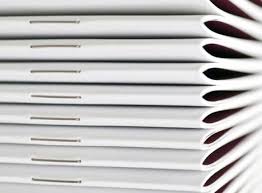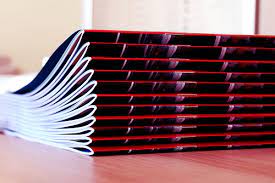
Saddle stitch binding is a cost-effective method for creating professional booklets and printed materials. It involves folding paper in half and stapling along the crease. This results in a flat-open booklet with a polished finish. MVP Print excels in various book binding techniques, including saddle stitch binding, delivering high-quality products to our Australian clients.
This binding method is popular in various industries, including instruction manuals and magazines. It’s chosen for its versatility, speed, and affordability. Ideal for projects with 8 to 64 pages, depending on paper thickness. Whether you need self-cover or plus-cover books, saddle stitch is a reliable choice.
Understanding Saddle Stitch Book Binding

Saddle stitching is a widely used binding technique for booklets, brochures, and small publications. It involves folding printed pages in half and stapling along the crease. This method produces a professional, affordable booklet that lies flat for reading.
History and Evolution of Saddle Stitch Book Binding
The technique of saddle stitching has been around for decades, starting in the early 20th century. It has seen advancements, with new staples and machines making large-scale production easier.
Basic Components of Saddle Stitch Book Binding
- Folded sheets of paper
- Staples or saddle stitches
- Dedicated saddle stitching machinery (for larger projects)
Why Choose Saddle Stitch Book Binding
Saddle stitched booklets and brochures are favored for many reasons. Efficient for booklets ranging between 8 to 76 pages, a saddle stitch booklet is:
- Cost-effective: Ideal for small to medium projects, saddle stitching is budget-friendly.
- Professional finish: They have a sleek look, with pages opening flat for a premium feel.
- Fast turnaround: Quick and efficient, perfect for urgent needs.
For marketing materials, educational guides, or any small publication, saddle stitching is a smart choice. It offers versatility and benefits.
Essential Materials and Tools Required

To create a beautifully bound saddle stitched book, you need the right materials and tools. The paper type is key, as it impacts the book’s look and feel. Lightweight papers (70-100 GSM) are best for brochures and booklets. Standard papers (100-120 GSM) suit a broad range of books. For a premium touch, choose heavyweight papers (120-200 GSM). Cover stock (200+ GSM) is best for projects needing a cover print.
Specialised wire staples, longer than standard office staples, are essential for saddle stitching. They provide the strength and durability needed to keep pages together. Saddle stitch books are particularly suitable for smaller publications like pamphlets and magazines due to their cost-effectiveness and quick production time. For bigger projects, dedicated machines streamline folding, collation, and stapling, ensuring efficiency and consistency.
For smaller projects, manual saddle stitching is feasible. You’ll need a handheld stapler, a bone folder for precise folding, a ruler for accurate measurements, and a needle for the spine. This method allows for a more personal touch but can be time-consuming for larger tasks.
| Paper Type | Suitability |
|---|---|
| Lightweight (70-100 GSM) | Ideal for brochures and informational booklets |
| Standard (100-120 GSM) | Great for a wide range of saddle stitched books |
| Heavyweight (120-200 GSM) | Provides a premium feel and durability |
| Cover stock (200+ GSM) | Perfect for cover-printed projects |
The Step-by-Step Binding Process
Crafting a professional-looking saddle stitched booklet requires a detailed binding process. Each step, from preparing the paper to the final stapling, is crucial for a high-quality finish.
Preparing the Paper
Start by folding each sheet of paper in half, creating a sharp crease. Use a bone folder or ruler to flatten the fold and achieve a crisp edge. After folding, stack the papers, ensuring the folds are neatly aligned.
Folding and Collating
Next, use a needle to poke evenly spaced holes along the paper fold, typically at 0.5 to 1 inch intervals. This allows the binding thread to pass through the pages. Stack the unfolded papers, ensuring the holes are perfectly aligned.
Stapling Techniques
Cut a piece of thread that is twice the length of the booklet. Tie a double knot at one end to prevent the thread from coming loose. Thread the needle and pull it through the first hole in an alternating pattern, ensuring the thread passes through each hole until the last one. Securely tie off the thread around the existing thread to complete the binding. Finally, trim any excess thread for a clean, professional finish.
Saddle stitched booklet binding is a straightforward and budget-friendly printing option. It involves key steps such as collation, folding, stapling, and trimming, making it suitable for booklets containing between 8 to 76 pages for various applications. This cost-effective and efficient binding method requires fewer materials and labour compared to other techniques. The resulting booklets open flat, allowing readers to engage with the content without the pages constantly closing. This binding process also enables quick turnaround times, making it an excellent choice for last-minute printing requirements.
Characteristics of Saddle Stitch Book Binding

Saddle stitched booklets are a popular choice for printing projects due to their cost-effectiveness, versatility, and professional appearance. Here are some key characteristics that make them stand out:
- Page Count: The total page count must be a multiple of four, including the front and back covers. This is because each folded sheet creates four pages.
- Maximum Page Count: Typically, saddle stitched booklets can accommodate up to 76 pages, although this can vary depending on the paper thickness and binding method.
- Cover Options: You can opt for a self-cover, where the cover is printed on the same paper stock as the interior pages, or a separate cover with a different finish or texture.
- Binding Process: The binding process involves using wire staples to attach the pages together along the spine, ensuring a secure and durable finish.
- Flat Opening: One of the standout features of saddle stitched booklets is their ability to lie flat when opened, making them easy to read and handle.
These characteristics make saddle stitched booklets an excellent choice for a wide range of applications, from marketing materials to educational resources.
Page Count and Design Considerations
When designing saddle stitched booklets, the page count is a critical factor. The minimum page count is 8 pages, with a recommended maximum of around 64 pages. However, the total page count must always be a multiple of four, as each folded sheet creates four pages.
Thicker papers can make the booklet bulkier, limiting the number of pages that can be bound together effectively. For inner pages, recommended paper weights range from90 to 150 gsm. The cover should be 120 to 150 gsm for optimal binding and appearance.
Layout considerations are vital for saddle stitched books. It’s important to place text and images away from the fold and staple areas to ensure content remains visible and accessible. Consistent outer margins of 3-5mm are recommended throughout the layout for a professional appearance.
The cover design significantly impacts the overall appeal of a saddle stitched book. Eye-catching colours, engaging imagery, and compelling typography can greatly enhance the booklet’s visual impact. Careful selection of colour schemes and typographic choices can significantly impact the readability and aesthetic appeal of the final product.
Saddle Stitching for Different Print Runs
Saddle stitching is a versatile binding method that can be adapted for both short and long print runs. Here’s how it works for different print run sizes:
- Short Print Runs (Less than 500 Booklets): For smaller quantities, a standard saddle stitching approach is often used. This involves hand-fed stitching with minimal setup time, making it a cost-effective option for limited runs.
- Long Print Runs (500-5,000 Booklets): For larger quantities, high-speed saddle stitching is recommended. This method uses wire staples and machinery to bind the booklets quickly and efficiently, ensuring consistency and quality.
- Very Long Print Runs (Over 5,000 Booklets): For extensive print runs, high-speed saddle stitching is combined with additional binding methods like perfect binding or case binding. This ensures durability and a professional finish, even for large-scale projects.
By choosing the appropriate saddle stitching method for your print run size, you can achieve high-quality results efficiently and cost-effectively.
Customization and Finishing Options
Saddle stitched booklets can be customized with various finishing options to enhance their appearance and functionality. Here are some common customization options:
- Cover Printing: The cover can be printed on the same paper stock as the interior pages or on a separate stock with a different finish or texture, adding a unique touch to your booklet.
- Folding and Creasing: The booklet can be folded and creased to create a compact and easy-to-handle format, perfect for distribution and storage.
- Trimming: The booklet can be trimmed to a specific size or shape to fit a particular design or branding requirement, ensuring a polished and professional look.
- Binding: While wire staples are the standard for saddle stitching, other binding methods like plastic coils can be used to create a secure and durable finish.
- Finishing: Enhance the booklet’s appearance and durability with techniques such as laminating, varnishing, or spot varnishing, giving it a premium feel.
These customization and finishing options allow you to create saddle stitched booklets that are not only functional but also visually appealing and aligned with your brand.
Eco-Friendliness of Saddle Stitch Book Binding

Saddle stitching is an eco-friendly binding method that produces minimal waste and uses environmentally friendly materials. Here are some of the eco-friendly benefits:
- Minimal Paper Waste: The binding process uses minimal paper waste, as the pages are stapled together along the spine without the need for glue or other adhesives.
- Recyclable Materials: The paper and staples used in saddle stitching are recyclable, making it a sustainable choice for printing projects.
- Energy Efficiency: The binding process is energy-efficient, as it uses minimal machinery and energy to produce the booklets, reducing the overall carbon footprint.
- Long-Lasting: Saddle stitched booklets are durable and long-lasting, reducing the need for frequent reprints and waste.
By choosing saddle stitching, you can create high-quality printed materials while also supporting environmentally friendly practices.
Advantages and Limitations
Saddle stitching is a favourite among those looking to save costs. It’s particularly beneficial for smaller projects, offering a budget-friendly option. This method also ensures a professional finish, allowing booklets to lie flat, which is a key feature for many users.
One of the standout benefits of saddle stitching is its speed. It’s perfect for urgent projects, as it can be completed swiftly. Its versatility is another plus, suitable for both small pamphlets and larger maps.
Cost Benefits
Compared to other methods like perfect binding, saddle stitching is more affordable. Its lower setup and production costs make it ideal for projects with tight budgets.
Design Flexibility
Saddle stitching allows for a wide range of design options. It’s compatible with various paper types and finishes, enabling the creation of visually appealing and practical publications.
Production Speed
The process of saddle stitching is straightforward, leading to faster production times. This makes it a practical choice for projects with urgent deadlines.
Despite its advantages, saddle stitching has its limitations. It’s best suited for booklets with 64 pages or less. For thicker books, other methods like perfect binding are more suitable, as they can handle higher page counts.
Professional Applications and Uses of Saddle Stitch Book Binding
Saddle stitched binding is a versatile printing technique used across various industries. Its cost-effectiveness and design flexibility make it a popular choice for a range of professional materials.
In the marketing and promotional realm, saddle stitched binding is commonly used for creating brochures, catalogues, and event programs. These materials often require regular updates and revisions. The speed of saddle stitching production makes it an ideal solution.
Within educational and instructional settings, saddle stitched instruction manuals, guidebooks, and training materials are widely adopted. The ability to lay these booklets flat and reference multiple pages simultaneously enhances the user experience.
- Saddle stitched binding is suitable for book and booklet printing of up to 48 pages, making it a cost-effective option for regularly published materials.
- Thicker paper can add bulk to saddle stitched booklets, requiring careful consideration of page count to maintain a professional appearance.
- Saddle stitched booklets are commonly used for brochures, catalogues, programs, and magazines, serving a range of marketing and promotional purposes.
In the publishing industry, saddle stitched binding is a popular choice for magazines, comic books, and other soft cover books. The technique allows for a clean, professional finish and easy reference for readers.
| Binding Type | Typical Applications | Advantages |
|---|---|---|
| Saddle Stitch | Booklets, brochures, catalogues, programs, magazines | Cost-effective, design flexibility, production speed |
| Perfect Binding | Paperbacks, annual reports, premium projects | Durability, clean spine, higher value |
| Hardcover/Case Binding | Books meant for sale | Longer shelf life, higher perceived value |
With its versatility and cost-effectiveness, saddle stitched binding continues to be a go-to solution for a wide range of professional applications. It is used for marketing materials, educational resources, and publications.
Handling and Reading Saddle Stitched Booklets
Saddle stitched booklets are designed to be easy to handle and read, offering several practical benefits:
- Easy to Handle: The booklet is easy to handle and maneuver, making it perfect for reading and referencing in various settings.
- Flat Opening: One of the standout features of saddle stitched booklets is their ability to lie flat when opened. This makes it easy to read and reference without the need for constant page-turning.
- Durable: The booklet is durable and long-lasting, reducing the need for frequent reprints and ensuring it can withstand regular use.
- Professional Appearance: With a sleek and polished finish, saddle stitched booklets have a professional appearance, making them ideal for business and marketing applications.
These features make saddle stitched booklets a practical and professional choice for a wide range of uses, from marketing materials to educational resources.
MVP Print’s Expertise in Saddle Stitch Book Binding

At MVP Print, we’re proud of our expertise in saddle stitched binding. As a top provider of binding services in Australia, we aim to deliver outstanding results. Our commitment to quality ensures every product we make meets the highest standards, from the binding process to the final touches.
Quality Assurance Process
Our quality assurance process is at the core of our operations. Skilled professionals meticulously check each step, from material selection to stitching. This focus on detail guarantees your printed materials look great and last long.
Available Services
At MVP Print, we offer a broad range of printing and binding solutions. Our services cover various printed materials, from small booklets to large publications. Whether it’s a small or large project, our team handles it with professionalism and care.
Customer Support
Exceptional customer support is key to our success at MVP Print. Our team works closely with clients to meet their specific needs. We ensure open communication from start to finish, aiming for your complete satisfaction.
With our expertise in saddle stitching, commitment to quality, and focus on customer support, MVP Print is a trusted partner. See the difference our dedication and attention to detail can make for your next project.
Conclusion
Saddle stitch book binding stands out as a top choice for its affordability and versatility. It offers a sleek finish, flexibility in design, and quick production times. This makes it perfect for marketing materials and educational resources.
Despite its limitations on page count, saddle stitching is ideal for projects with smaller budgets and fewer pages. With the help of experts like MVP Print, you can create materials that stand out. They engage your audience and clearly convey your message.
The growing need for affordable, efficient printing solutions keeps saddle stitch book binding in high demand. It’s ideal for creating compact brochures or short-run magazines. This technique ensures your printing goals are met with precision and a professional touch.








